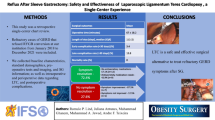Abstract
Background
In up to 4% of laparoscopic Roux-en-Y gastric bypass (LRYGB) procedures, anastomotic leaks occur. Early detection of gastrointestinal leakage is important for successful treatment. Consequently, many centers advocate routine postoperative upper gastrointestinal (UGI) series. The aim of this study was to determine the utility of this practice after LRYGB.
Methods
Eight hundred four consecutive patients undergoing LRYGB from June 2000 to April 2010 were analyzed prospectively. The first 382 patients received routine UGI series between the third and fifth postoperative days (group A). Thereafter, the test was only performed when clinical findings (tachycardia, fever, and drainage content) were suspicious for a leak of the gastrointestinal anastomosis (group B; n = 422).
Results
Overall, nine of 804 (1.1%) patients suffered from leaks at the gastroenterostomy. In group A, four of 382 (1%) patients had a leak, but only two were detected by the routine UGI series. This corresponds to a sensitivity of 50%. In group B, the sensitivity was higher with 80%. Specificities were comparable with 97% and 91%, respectively. Routine UGI series cost only 1.6% of the overall costs of a non-complicated gastric bypass procedure. With this leak rate and sensitivity, US $86,800 would have to be spent on 200 routine UGI series to find one leak which is not justified.
Conclusions
This study shows that routine UGI series have a low sensitivity for the detection of anastomotic leaks after LRYGB. In most cases, the diagnosis is initiated by clinical findings. Therefore, routine upper gastrointestinal series are of limited value for the diagnosis of a leak.


Similar content being viewed by others
References
Kral JG. Morbidity of severe obesity. Surg Clin North Am. 2001;81(5):1039–61.
Klein S. Medical management of obesity. Surg Clin North Am. 2001;81(5):1025–38. v.
Buchwald H, Avidor Y, Braunwald E, et al. Bariatric surgery: a systematic review and meta-analysis. Jama. 2004;292(14):1724–37.
Maggard MA, Shugarman LR, Suttorp M, et al. Meta-analysis: surgical treatment of obesity. Ann Intern Med. 2005;142(7):547–59.
Sjostrom L, Lindroos AK, Peltonen M, et al. Lifestyle, diabetes, and cardiovascular risk factors 10 years after bariatric surgery. N Engl J Med. 2004;351(26):2683–93.
Wittgrove AC, Clark GW, Tremblay LJ. Laparoscopic gastric bypass, Roux-en-Y: preliminary report of five cases. Obes Surg. 1994;4(4):353–7.
Lujan JA, Frutos MD, Hernandez Q, et al. Laparoscopic versus open gastric bypass in the treatment of morbid obesity: a randomized prospective study. Ann Surg. 2004;239(4):433–7.
Nguyen NT. Open vs. laparoscopic procedures in bariatric surgery. J Gastrointest Surg. 2004;8(4):393–5.
Nguyen NT, Goldman C, Rosenquist CJ, et al. Laparoscopic versus open gastric bypass: a randomized study of outcomes, quality of life, and costs. Ann Surg. 2001;234(3):279–89. discussion 289–291.
Westling A, Gustavsson S. Laparoscopic vs open Roux-en-Y gastric bypass: a prospective, randomized trial. Obes Surg. 2001;11(3):284–92.
Schauer PR, Ikramuddin S, Gourash W, et al. Outcomes after laparoscopic Roux-en-Y gastric bypass for morbid obesity. Ann Surg. 2000;232(4):515–29.
Wittgrove AC, Clark GW. Laparoscopic gastric bypass, Roux-en-Y-500 patients: technique and results, with 3–60 month follow-up. Obes Surg. 2000;10(3):233–9.
Byrne TK. Complications of surgery for obesity. Surg Clin North Am. 2001;81(5):1181–93. vii–viii.
Ovnat A, Peiser J, Solomon H, et al. Early detection and treatment of a leaking gastrojejunostomy following gastric bypass. Isr J Med Sci. 1986;22(7–8):556–8.
Hamilton EC, Sims TL, Hamilton TT, et al. Clinical predictors of leak after laparoscopic Roux-en-Y gastric bypass for morbid obesity. Surg Endosc. 2003;17(5):679–84.
Toppino M, Cesarani F, Comba A, et al. The role of early radiological studies after gastric bariatric surgery. Obes Surg. 2001;11(4):447–54.
Serafini F, Anderson W, Ghassemi P, et al. The utility of contrast studies and drains in the management of patients after Roux-en-Y gastric bypass. Obes Surg. 2002;12(1):34–8.
Muller MK, Guber J, Wildi S, et al. Three-year follow-up study of retrocolic versus antecolic laparoscopic Roux-en-Y gastric bypass. Obes Surg. 2007;17(7):889–93.
Mason EE, Printen KJ, Barron P, et al. Risk reduction in gastric operations for obesity. Ann Surg. 1979;190(2):158–65.
Carucci LR, Turner MA, Conklin RC, et al. Roux-en-Y gastric bypass surgery for morbid obesity: evaluation of postoperative extraluminal leaks with upper gastrointestinal series. Radiology. 2006;238(1):119–27.
Smith C, Gardiner R, Kubicka RA, et al. Gastric restrictive surgery for obesity: early radiologic evaluation. Radiology. 1984;153(2):321–7.
Doraiswamy A, Rasmussen JJ, Pierce J, et al. The utility of routine postoperative upper GI series following laparoscopic gastric bypass. Surg Endosc. 2007;21(12):2159–62.
Bertucci W, White S, Yadegar J, et al. Routine postoperative upper gastroesophageal imaging is unnecessary after laparoscopic Roux-en-Y gastric bypass. Am Surg. 2006;72(10):862–4.
Lee SD, Khouzam MN, Kellum JM, et al. Selective, versus routine, upper gastrointestinal series leads to equal morbidity and reduced hospital stay in laparoscopic gastric bypass patients. Surg Obes Relat Dis. 2007;3(4):413–6.
Conflicts of interest
All authors declare that they have no conflict of interest.
Author information
Authors and Affiliations
Corresponding author
Additional information
Marc Schiesser and Josef Guber equally contributed to the paper.
Rights and permissions
About this article
Cite this article
Schiesser, M., Guber, J., Wildi, S. et al. Utility of Routine Versus Selective Upper Gastrointestinal Series to Detect Anastomotic Leaks After Laparoscopic Gastric Bypass. OBES SURG 21, 1238–1242 (2011). https://doi.org/10.1007/s11695-010-0284-y
Published:
Issue Date:
DOI: https://doi.org/10.1007/s11695-010-0284-y




